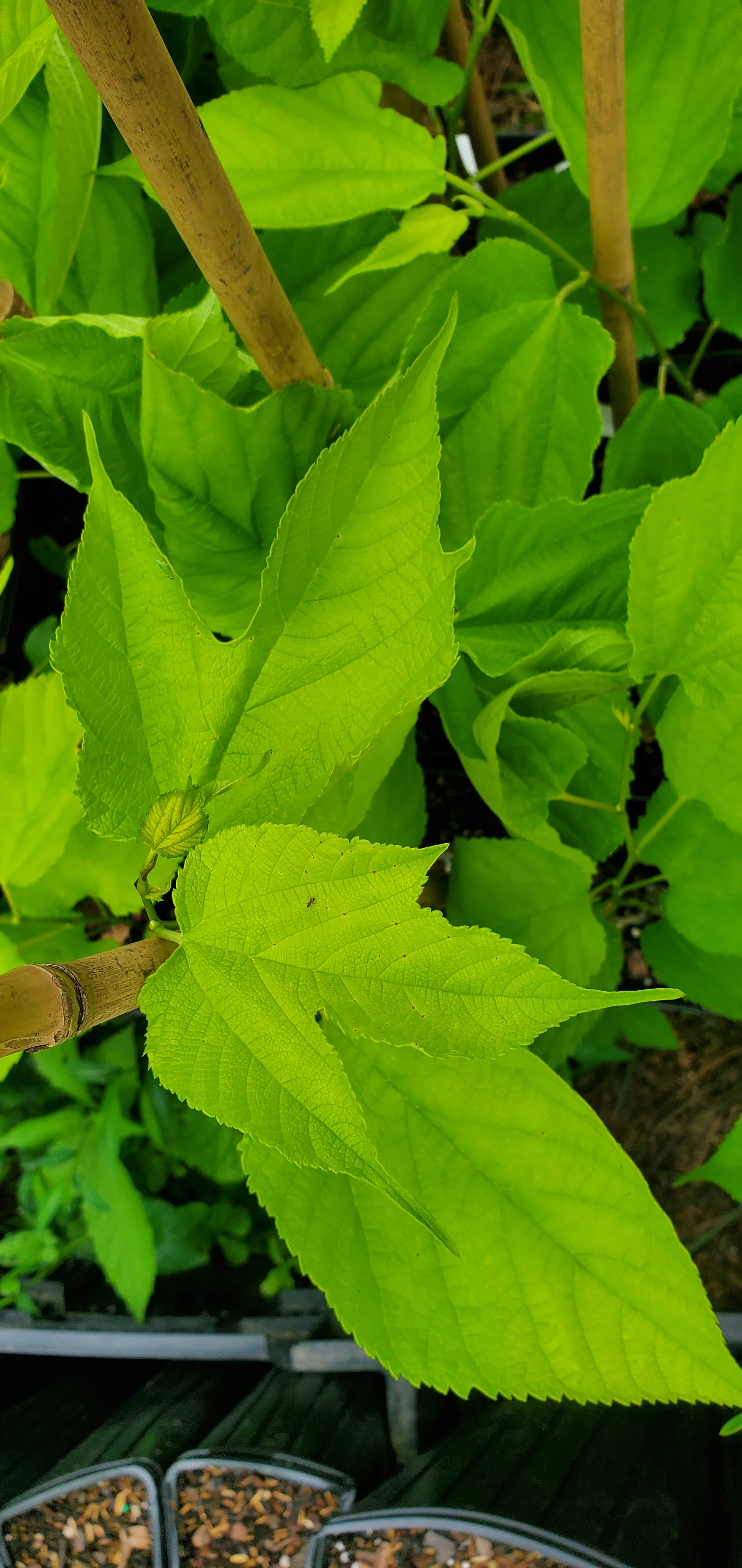 Image 1 of 3
Image 1 of 3

 Image 2 of 3
Image 2 of 3

 Image 3 of 3
Image 3 of 3




Native Morus rubra mulberry
These grafted selections are the true Morus rubra, native denizen of rich, floodplain forests across the eastern US. True, non-hybrid Morus rubra is identified by its large, coarse-textured leaves lacking any glossy finish. The veins are deeply embossed, and each leaf features a prominent acuminate drip tip. Where leaves divide into lobes, each lobe also ends in an acuminate drip tip. The bark is grey-brown and plated. Fruits are generally long and slender with a delicious flavor. There are other subtle features which distinguish our native mulberry from Morus alba and the many variations of alba x rubra hybrids. Based on morphological features, and in a few cases genotype confirmation, the ones listed here are the real deal rubra. Morus rubra will not root from cuttings, unlike Morus alba, therefore grafting is a necessity for preserving specimens of this species.
Daugherty #1 — fruiting female Morus rubra selection from Georgia.
Daugherty #2 — monoecious Morus rubra selection from Georgia which produces both male (staminate) and female (fruiting) flowers.
Harmony Grove — fruiting (female) Morus rubra selection from Hopkinsville, KY introduced by Lucky Pittman. Fruits described as plump and tasty but not quite as large as the fruits of Illinois Everbearing. Tested as pure Morus rubra, according to a 2022 SARE grant.
Outland A — male Morus rubra selection from Kentucky.
Roberts farm #5, 6, & 7 — Morus rubra selections from Kentucky.
Rowland Lakehouse — fruiting (female) Morus rubra selection from Kentucky, from Lucky Pittman.
Spillway — fruiting (female) Morus rubra selection from Lucky Pittman in Kentucky. Tested as pure Morus rubra according to the 2022 SARE grant.
Workman — male Morus rubra selection.
These mulberry trees come in 4” x 14” tree pots and have at least about a foot of growth above the graft union, or more.
These grafted selections are the true Morus rubra, native denizen of rich, floodplain forests across the eastern US. True, non-hybrid Morus rubra is identified by its large, coarse-textured leaves lacking any glossy finish. The veins are deeply embossed, and each leaf features a prominent acuminate drip tip. Where leaves divide into lobes, each lobe also ends in an acuminate drip tip. The bark is grey-brown and plated. Fruits are generally long and slender with a delicious flavor. There are other subtle features which distinguish our native mulberry from Morus alba and the many variations of alba x rubra hybrids. Based on morphological features, and in a few cases genotype confirmation, the ones listed here are the real deal rubra. Morus rubra will not root from cuttings, unlike Morus alba, therefore grafting is a necessity for preserving specimens of this species.
Daugherty #1 — fruiting female Morus rubra selection from Georgia.
Daugherty #2 — monoecious Morus rubra selection from Georgia which produces both male (staminate) and female (fruiting) flowers.
Harmony Grove — fruiting (female) Morus rubra selection from Hopkinsville, KY introduced by Lucky Pittman. Fruits described as plump and tasty but not quite as large as the fruits of Illinois Everbearing. Tested as pure Morus rubra, according to a 2022 SARE grant.
Outland A — male Morus rubra selection from Kentucky.
Roberts farm #5, 6, & 7 — Morus rubra selections from Kentucky.
Rowland Lakehouse — fruiting (female) Morus rubra selection from Kentucky, from Lucky Pittman.
Spillway — fruiting (female) Morus rubra selection from Lucky Pittman in Kentucky. Tested as pure Morus rubra according to the 2022 SARE grant.
Workman — male Morus rubra selection.
These mulberry trees come in 4” x 14” tree pots and have at least about a foot of growth above the graft union, or more.